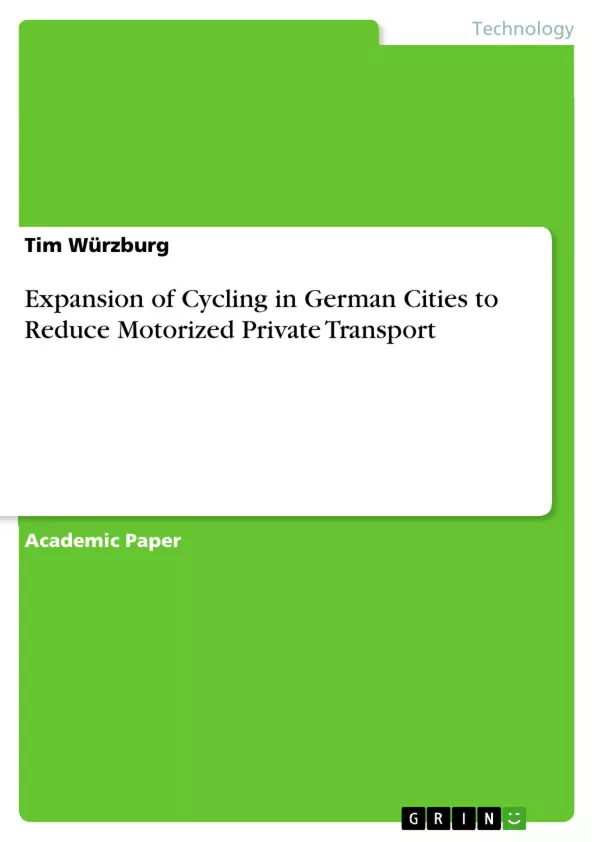In this scientific paper, the authors ask the question: Is it possible to reduce motorized private transport by expanding the bicycle infrastructure in German cities?
The bicycle is an environmentally friendly and health-promoting alternative to motorized private transport and is also more cost-effective. Currently, the bicycle is not yet being used to the extent that it could be. Far too many people resort to the car for a variety of reasons. This paper examines possible reasons, such as safety issues, time, weather, and road users' states of mind, that prevent daily bicycle use.
In the following, measures and guidelines are presented on how it is possible to enable safer, more structured, and more flexible bicycle traffic in German cities and thus exert a positive influence on the overall traffic. The focus is on infrastructural measures such as improved marking of bicycle lanes, the development of bicycle highways or new concepts for crossing areas, the development of a joint concept between public transport and a traffic-regulating fee for motorized private transport.
Since a gap in the research on whether these measures can be implemented in the eastern German city of Dresden was found, a SWOT matrix is used to analyze the concrete possibilities that can be implemented and to evaluate possible opportunities and potential risks. The strengths as well as the weaknesses, that emerge from the cityscape, society, and political measures, serve as a basis.
Inhaltsverzeichnis (Table of Contents)
- Introduction
- The current state of bicycle traffic in Germany
- Classification of bicycle traffic in the overall German traffic situation
- Advantages of the bicycle
- Disadvantages of the bicycle
- Perception of the population on the current cycling situation
- Hazard prevention through infrastructural adjustments
- New mobility design bicycle lane marking and separation
- Bicycle highways – save and fast bicycle paths
- Redesign of intersection areas for more safety
- The city toll - Motor traffic regulating measure
- Improving the bicycle volume through combination with the local public transport system
- SWOT analysis regarding the bicycle suitability of Dresden
- Conclusion
Zielsetzung und Themenschwerpunkte (Objectives and Key Themes)
This scientific paper aims to analyze the current state of bicycle traffic in Germany, focusing on the potential for expanding cycling in urban areas to reduce motorized private transport. The paper examines various factors affecting the suitability of bicycles as a mode of transportation, explores strategies for improving safety and infrastructure, and provides a SWOT analysis for the city of Dresden.
- The current state of bicycle traffic in Germany
- Hazard prevention through infrastructural adjustments
- The role of urban planning and design in promoting cycling
- The feasibility of expanding cycling in urban areas
- The impact of cycling on reducing motorized private transport
Zusammenfassung der Kapitel (Chapter Summaries)
- Introduction: This chapter provides a brief overview of the topic and the paper's objectives.
- The current state of bicycle traffic in Germany: This chapter analyzes the current state of bicycle traffic in Germany, including the classification of bicycle traffic within the overall traffic situation, the advantages and disadvantages of cycling, and public perception of the current cycling situation.
- Hazard prevention through infrastructural adjustments: This chapter examines various infrastructural measures to enhance cycling safety and encourage more people to choose cycling as a mode of transportation. It explores concepts like new mobility design for bicycle lanes, dedicated bicycle highways, intersection redesign for safety, city tolls for regulating motor traffic, and integration of cycling with public transport systems.
- SWOT analysis regarding the bicycle suitability of Dresden: This chapter presents a SWOT analysis of Dresden, evaluating the city's suitability for promoting cycling. It examines strengths, weaknesses, opportunities, and threats related to cycling infrastructure and its potential for expansion.
Schlüsselwörter (Keywords)
The primary keywords and focus topics of this paper include: cycling infrastructure, urban planning, bicycle traffic, safety, sustainable transportation, SWOT analysis, Dresden, Germany, motorized private transport, traffic management, public transport integration.
- Quote paper
- Tim Würzburg (Author), 2021, Expansion of Cycling in German Cities to Reduce Motorized Private Transport, Munich, GRIN Verlag, https://www.grin.com/document/1060895



